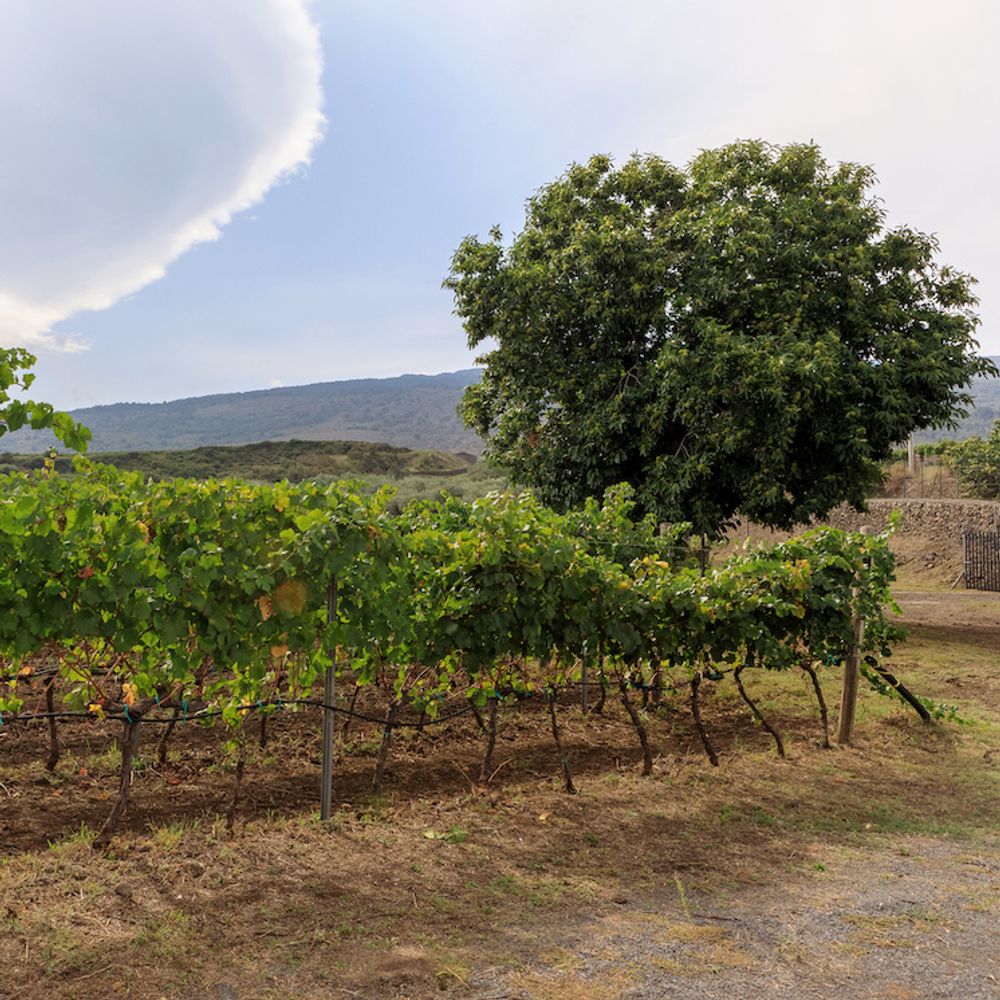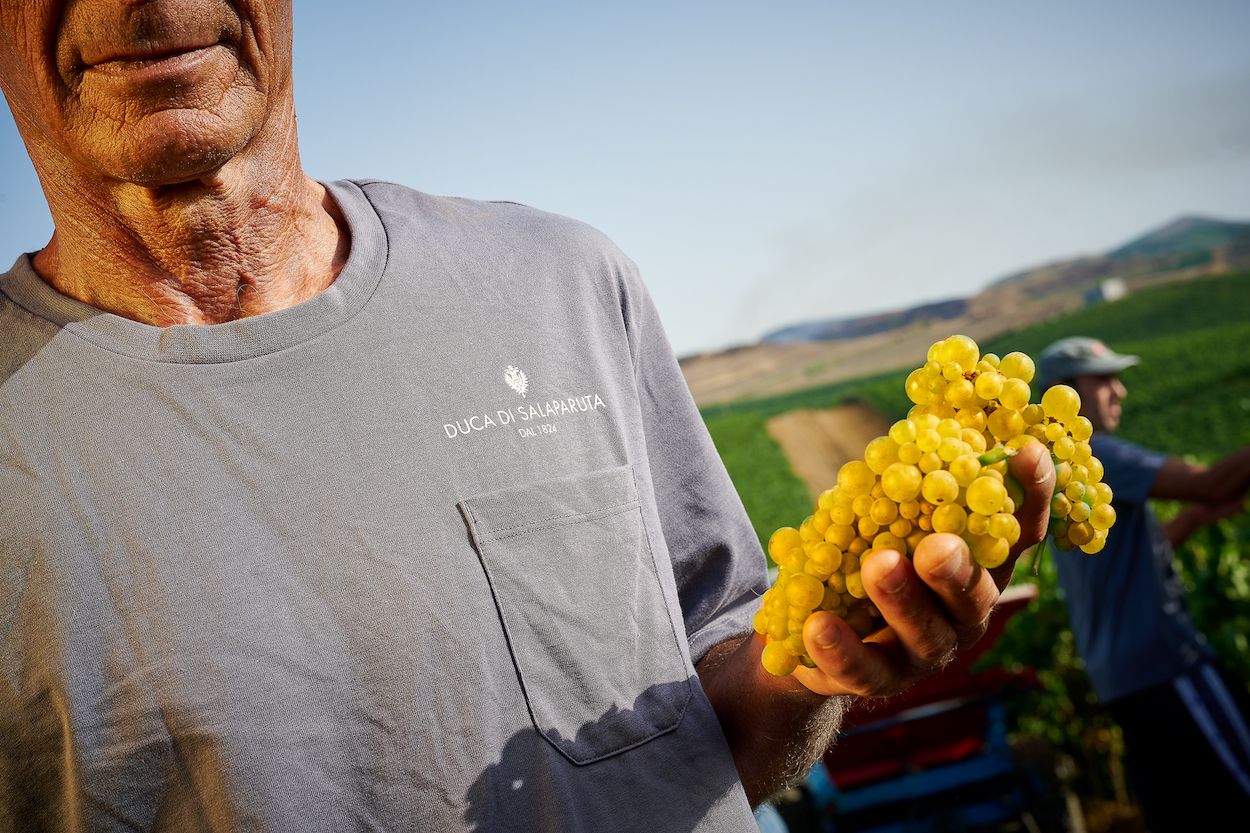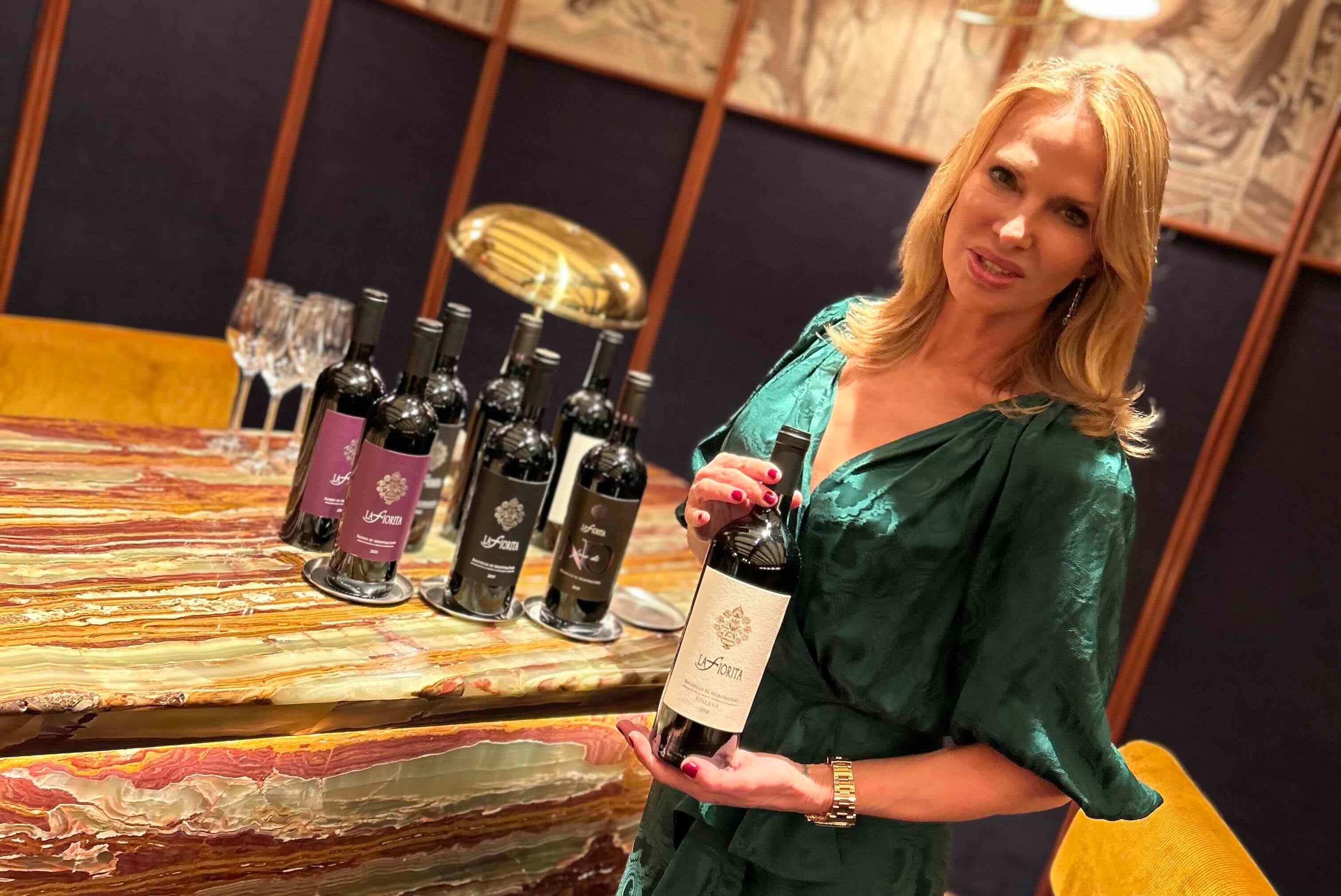“The Duca di Salaparuta strategy of spreading itself – geographically and by wine variety – makes sense, both from a commercial and strategic point of view,” writes Keay.

Sicily today is best understood as a continent in miniature, with harvests starting in the south in late August and wrapping up on the higher reaches of Mt Etna in early November.
“If we want things to stay as they are, things will have to change,” Tancredi Falconieri tells his uncle Fabrizio Corbera, Prince of Salina in The Leopard, Giuseppe di Lampadusa’s seminal book about the challenges facing Sicily’s aristocracy during the Risorgimento.
This famous quotation came to me earlier this year when I travelled to Sicily for Sicilia En Primeur/ Assovini Sicilia, the annual gathering of almost 100 Sicilian wine producers that was held in scenic Taormina and which will next year celebrate its 20th anniversary.
Blessed with an ideal climate (regular sunshine and decent rainfall) and varied and fertile soils, winemaking in Sicily dates back at least 6000 years. Sicily’s size – the island is Italy’s biggest wine region, by area – means that the big variations in climate and soil, give winemakers much to play with.
Meanwhile, big differences in elevation have enabled vineyards to be planted everywhere from near sea level to high altitude, including on fertile, volcanic Mount Etna at heights of up to 1000 metres. Such terroir has become increasingly valuable as climate change forces winemakers to become more inventive.

Harvest in Suor Marchesa © Benedetto Tarantino
The speed of change
A lot has actually already changed, wine-wise, in Sicily from when Assovini (established in 1998) launched its inaugural event in 2004.
Back then, the largest island in the Mediterranean was seen mainly as a source of cheap bulk wine; whilst iconic producers such as Donnafugata (inspired also by The Leopard, where ‘The Leopard’ Corbera had his fictional summer residence), were around – and celebrated its 40th birthday this year – most of today’s top Sicilian names like Planeta, Cusumano and Benanti were all pretty much just getting started.
Etna, perhaps the island’s most famous DOC, had just 30 or so producers; now there are around 180 making quality reds and increasingly whites too, whilst the number of DOCs has risen to 23 (there is just one DOCG, Cerasuolo di Vittoria) and the number of IGPs is seven – an increasingly important category given the shift towards experimentation.
At the same time, producers have been taking advantage of the island’s unique array of at least 65 grape varieties. These include white Grillo, Insolia, Zibibbo, Catarratto and Carricante, and amongst the reds, Nero d’Avola, Nerello Mascalese and Nerello Cappuccio. Winemakers today also work with international varieties including Vermentino, Chardonnay, Pinot Nero and Malbec.
Unsurprisingly then, the wines shown at this year’s Assovini Sicilia were generally impressive, with a clear trend towards native grapes, recognising these show Sicily at its best and are hardier in facing up to what can be difficult weather conditions.
Assovini Sicilia president, Laurent Bernard de la Gatinais, says Sicily today is best understood as a continent in miniature, with harvests starting in the south in late August and wrapping up on the higher reaches of Mt Etna in early November.
Alongside Sicily’s varieties, he sees the DOCs key to the island’s emergence as a varied, quality wine region which can stand alongside Tuscany and Piedmont.
“Our focus on building up and consolidating their reputation (including the important Sicilia DOC) has been key to promoting Sicily as an evolving, ever improving world class wine region,” he told me.

Duca di Salaparuta winemaker Barbara Tamburini
Duca di Salaparuta – 199 years and counting
Amongst the wineries at the gathering was one of Sicily’s oldest producers Duca di Salaparuta, which next year celebrates its 200th anniversary. Together with Corvo – the entry level Sicilian wine of choice in the UK in the 1980s and 1990s – and historic Marsala producer Florio, it is owned by the Reina Family and comprises the largest private wine group on the island.
Yet it would be fair to say that this iconic producer is not that well known in the UK market, which probably explains its decision to show a range of its wines – including its so-called icons – at a Zoom tasting in early November, hosted by Tuscany-born winemaker Barbara Tamburini, who joined the group in 2020.
“You can’t really understand Sicily as a wine region – it’s vast, with huge variations in climate, soil and elevation. For me coming from a region which is so different in almost every respect, the oenological experience has been amazing,” she says.
Indeed, as if to prove the point, Duca di Salaparuta spans the island, with two wineries at Casteldaccia near Palermo and at Trapani, the region best known for Marsala, and three unique estates, which define the group’s approach to varietal expression, with winemaking defined by minimal use of pesticides and chemicals, and grapes typically hand-selected and picked.

Vines enjoying the perfect climate at Risignolo
Insolia and Grillo shine at the Risignolo estate
In the west at the 35-hectare Risignolo estate, two native varieties are grown: Grillo (an increasingly widely planted and popular variety originally blended from Cataratto and Muscat d’Alexandrie) and Insolia in sandy-clay soils that give great expression and where the vines enjoy a perfect climate, cooled by sea winds in the summer. The two varieties are used to make Marsala but Duca di Salaparuta has been experimenting with dry versions of each.
First up, one of the group’s icon wines, Bianca de Valguarnera IGT Terre Siciliane 2020(13.5%) is made from 100% Insolia (aka Ansonica) and is one of the more striking wines I have tasted this year. Hand harvested at full ripening in late September, the grapes for Bianca de Valguarnera spend twelve months on their lees in barrique before bottling; the wine is yellow golden in colour, full bodied and dry with notes of marzipan, quince and vanilla supporting the long, luxurious finish. Very much a wine that stays with you.
Also made here is Kados Sicilia DOC Grillo 2022 (12.5%), a surprisingly rich take on the variety thanks to 40 days on the lees and wood fermentation. Made from hand-picked estate fruit, this is really well made and very enjoyable, with lychee and peach on the finish: helps you understand why this variety is one of the fastest growing, in terms of plantings, in Sicily.

“In the middle of nowhere,” – the estate at Suor Marchesa © Benedetto Tarantino
Nero d’Avola and Vermentino shine at the Suor Marchesa estate
In Riesl in south-central Sicily is the Suor Marchesa estate, home to an excellent climate – mild short winters and sunny summers eased by the cooling winds of the sea. Barburini says a visit to this 127-hectare estate is essential, to understand its vast scale and potential.
“You arrive and feel literally you are in the middle of nowhere – you can hear the wind blowing and pretty much nothing else,” she says.
The limestone soil here has enabled great cultivation of Sicily’s best known red grape Nero d’Avola, the variety which gives unique character to the groups’ Icon wine, the Duca Enrico 2019 (14.5%) alongside a very different take on the variety, the Passo delle Mule Nero d’Avola Sicilia DOC 2021 (13.5%), with the two wines vinified in completely different ways.
Tasted alongside each other, the Duca Enrico, now in its 35th vintage, is a full bodied but nuanced Nero d’Avola, with firm acidity supporting red and dark berry fruit, the expression reinforced by smooth tannins which give the wine remarkable length and ageing capacity. Made from hand-harvested grapes, showing mainly red but also dark berry fruit, this wine is rich with soft acidity and warm tannins. There’s great concentration, as you might expect from old vines, with good complexity yet the wine is also very approachable: rather on the woody side at first, it settles down after some hours in a decanter.
By contrast, the Passo delle Mule (Step of the Mule) sees some wood but is mostly aged in stainless steel tanks to produce a wine that is quite intense and fruit forward, showing blackberry and blueberry notes, but is still maybe a little on the young side.
The producer is stepping up production of other varieties including Syrah, Frappato and Merlot, yet some of the most promising results have come from Vermentino. The appropriately named Sentiero del Vento Terre Siciliane IGT 2022 (12.5%) is a real surprise (my first Sicilian Vermentino), fruit forward but fresh with good acidity reflecting the fact the grapes were taken from a hillside site and picked early to preserve the crispy acidity. Barburini can’t conceal her enthusiasm.
“I’ve worked with Vermentino for 25 years and I wasn’t expecting this to show as well. Others I’ve shown it to say it compares well with Vermentino from Sardinia, Tuscany and Liguria, which suggests this variety has great potential here,” she says.

Vajasindi © Benedetto Tarantino
Duca di Salaparuta makes its first foray into Etna at the Vajasindi estate
To the east, in Passopisciaro near Mount Etna is the 21-hectare Vajasindi estate, with its volcanic soil and three terraces, one at 700m above sea level, the other two 620m. This area on the northern slopes of Etna is home to indigenous Nerello Mascalese and Carricante but Pinot Nero is also planted here – Duca di Salaparuta is one of the pioneers of the grape in Sicily, making its well-regarded Nawari Pinot Nero.
Barburini and her team were showing two new wines to the portfolio, the Lavico Etna Rosso 2021 (13.5%) and Lavico Etna Bianco 2022 (12.5%). The former, made from 100% Nerello Mascalase had some wood contact but is mostly fermented in stainless steel tanks, and the resulting wine is quite light and fruity, a young wine that clearly needs more time but shows good expression of the variety, with nice sapidity.
The 100% Carricante Lavico Etna Bianco, like the Etna Rosso, is made from grapes grown in vineyards 600-800m above sea level with big diurnal temperature changes and showing Etna’s volcanic character in a mineral palate with exotic suggestions of guava and mango on the finish.
The Lavico wines were established just a few years ago and are clearly a work in progress, as these wines showed, but the potential here is considerable and it is interesting to see Duca di Salaparuta make its first foray into Etna, where vineyard prices recently hit record highs.
And in conclusion…
Although quality across Sicily has been rising, Mother Nature hasn’t always been kind, particularly recently. Heavy rains in May-June were followed by a summer heatwave, and widespread incidence of downy mildew affecting much of the grape-stock combined to reduce the island’s harvest by some 30% – after a tricky 2022. However, regions and varieties were differently impacted, which suggests the Duca di Salaparuta’s strategy of spreading itself – geographically and by wine variety – makes sese, both from the commercial and strategic point of view.
Taken together, these are exciting, modern wines with a very firm sense of tradition that clearly deserve to be better known on the UK market. Wines, in other words, that would make Fabrizio, the Prince of Salina, and his nephew Tancredi, very proud, and which encapsulate Sicily’s viticultural renaissance.



































